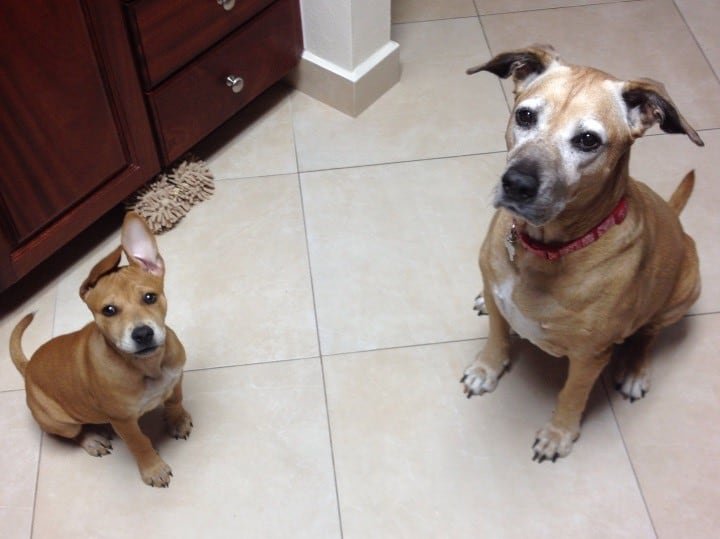What To Do When Your Vet Won’t Listen

There are some affiliate links below, but they are all products I highly recommend. For more info, view my disclosure here.
One of the bigger drawbacks of being a military family who moves every few years has been finding a quality veterinarian that knows our pets and is willing to help them be their healthiest and happiest.
While we’ve been lucky and had some amazingly wonderful vets, we’ve also had our fair share of less-than-stellar vets.
While they may have been fine for basic issues such as hot spots, infections, or vaccinations, they sometimes weren’t willing or able to help with more complicated issues such as cancer or thyroid concerns.
Read on for our worst veterinary stories and see what you can do when your vet won’t listen and appropriately care for your dog.
Ginger’s Cancer Story
Right after our Ginger turned 14, she developed a mystery lump on her leg. We took her to our vet in Puerto Rico, just days before moving to Alaska.
He thought it was possibly a lipoma, which is a fatty tumor that is often benign. Given the fact that she was going to be flying across the country in a few days, he advised us to have it biopsied when we got to Alaska.
Once we arrived in Alaska, we took Ginger in and the biopsy came back clean, with no cancer cells.
Unfortunately, that was just because they hadn’t spread to the point of being picked up in the biopsy yet, and the lump kept growing.
We brought her to the local vet and scheduled surgery to remove the lump and send it off for a pathology result.
The surgery went well, and we were happy to have our girl back to normal. Until a few days later, when the stitches reopened and the lump was plainly visible.
Apparently, the vet that did the initial surgery had only managed to remove part of the lump. Once the cells were spread, cancer proceeded to grow exponentially fast.
We rushed Ginger back to the vet for a follow-up and received the results of her pathology report and cancer diagnosis – soft tissue sarcoma.
Soft tissue sarcoma is a rare type of cancer that grows rapidly in tissues surrounding skin, muscle, fat, and blood vessels. Living in Alaska, chemotherapy wasn’t an option, nor were there any other therapies we could try.
We even considered flying down with her to Seattle for treatment, but flying with open wounds like hers wasn’t possible.
Even though Ginger was an amazingly healthy girl, the vet had no other suggestions besides putting her down in a few days.
We knew Ginger was absolutely not ready to go.
Her quality of life was essentially that of an 8-year-old dog and she was happy and healthy, despite the lump on her leg. We were devastated that it was coming to having to put down a healthy senior dog only because the vet had no other options.
Thankfully, we ended up taking Ginger in for a second opinion to a much better veterinarian.
She was so impressed by Ginger’s mobility and overall health that we decided to redo the surgery to see if she could clear off a wider margin around the lump to remove all the cancer cells.
Once she got Ginger into surgery, however, it was evident that cancer had spread too far in her leg and she wouldn’t be able to get clean enough margins.
She suggested amputation of the leg. We were hesitant because while Ginger was in great health, wouldn’t that be too hard on a senior dog?
She asked about our specific concerns, walked us through them, and was very honest about the challenges. She also said she agreed Ginger wasn’t ready to go and she fully believed Ginger would be fine after the amputation.
With that, we agreed and she proceeded to do the amputation.
It was AMAZING. We picked up Ginger from the clinic that night. Some veterinary offices prefer to keep them overnight after that type of surgery, but ours didn’t feel that was necessary with her.
She was completely correct as Ginger was awake and ready to eat within hours of bringing her home! We were happy, yet not at all surprised because nothing came between Ginger and food!
She was on a good amount of pain pills, but managed to stand up and then squat a bit to pee by the next day, when I took the picture below.
Her progress was incredible and without the help of a wonderful vet on our side, she wouldn’t have been with us.
Over the next 9 months, Ginger was perfectly healthy. She was mobile, able to get around easily, and even played with toys and even started playing with her mostly annoying younger brother Rico, who was absolutely in love with her.
She had a wonderful quality of life and plenty of pizza until she reached 15 years old when she rapidly declined over the course of a few days and we were able to have a vet come to our house for her goodbye.
Roxy’s Current Thyroid Issues
Winter in Alaska is a time when life slows down a bit, but we still make it a priority to stay active even when the snow is coming down. Once the weather warmed up, we noticed Roxy started getting a bit lethargic and lazy.
We brought it up to her vet at her annual checkup and he told us she just needs to lose weight. We pointed out that she was on the same food and quantity as her brother Rico, and he weighed around 8 pounds less with similar activity levels.
Regardless, the vet had us change her food to Purina Healthy Weight. She not only failed to lose weight, but gained 2 pounds while on weight management food.
Then she started experiencing some pretty intense behavior changes. Suddenly, she was more anxious than she used to be over fireworks and noises like the garbage truck.
Little things that she’d normally ignore or just perk up at would now end up in her barking her head off or shaking like a leaf.
Then she started picking fights with her brother Rico. It only happened a few times, and they were short, intense fights that we were able to end quickly.
However, everything escalated over the course of a week where she started more violently attacking him, with seemingly no reason.
One time she attacked Rico while he was taking a drink of water. Another time, they were asleep when the new air conditioner unit turned on. The noise startled Roxy awake and she immediately lunged at Rico.
There was no resource guarding motivation. It was just so unpredictable.
When your dog has such sudden behavior changes, you can’t help but start to think of the worst-case scenarios.
I’ve heard of brain tumors causing similar aggression and even just thinking of that was devastating. We are a family, and rehoming wasn’t an option, but neither was letting Roxy & Rico fight.
I didn’t know how we were going to deal with car rides in the future, not to mention boarding them if we had to leave town.
The thought of my normally super snuggly pups never cuddling again was heartbreaking. Plus, with them being separated from each other, Rico’s separation anxiety was getting worse.
He loved his sister and couldn’t understand why she was being SO mean!
They were both small puppies when we rescued them a few months apart, and have been together for over 5 years. They’re extremely bonded normally, so this was a massively drastic change.
Luckily, even though the fights were terrifying, both Roxy and Rico showed great bite inhibition with each other and they only had fairly minor cuts and scrapes. But the fights were becoming more intense, and it wasn’t safe for either of them.
It rapidly escalated to the point Roxy couldn’t even be in the same room as Rico. When they were near each other, she would stalk him while getting ready to fight.
We tried putting a muzzle on her, but that didn’t stop her rage. She would still try to attack even with the muzzle on. Rico is the best boy and wouldn’t retaliate, though.
I knew with everything in me that this wasn’t normal aggression, especially for two very bonded dogs, and she wasn’t healthy.
This was all happening just days before a long-awaited girl’s trip to visit my cousin in Los Angeles.
Dan was going to be home with Roxy & Rico, but I was panicking because of how persistent the fights were becoming and how difficult they were for one person to break them up.
I started researching every possible health issue that could be causing this behavior.
All signs were pointing to an underactive thyroid.
Unfortunately, the vet that helped Ginger was out of town so we weren’t able to bring Roxy to see her.
While I debated on canceling my trip, I was able to get Roxy a last-minute vet appointment at a newer, highly recommended veterinary clinic in town.
I also reached out to our favorite boarding kennel and they were able to squeeze Rico in so I didn’t have to worry about them fighting while I was away.
Then Our Vet Didn’t Listen To Me
My husband came home from work early the day of her appointment. We were both extremely concerned with the behavior changes and wanted to take her to the vet appointment together.
Once the vet came in I laid out all our concerns and symptoms, and how it was likely due to an underactive thyroid.
The vet proceeded to be dismissive of every symptom.
The dark, bald patch on her tail was just normal. The cold intolerance was because we live in Alaska. The weight gain meant she was getting too much food and was lazy. And her aggression was just that she needs training.
There are over 70 symptoms of thyroid disorder. Just a few of the ones Roxy was exhibiting included:
- lethargy
- weight gain
- mental dullness
- cold intolerance
- exercise intolerance
- aggression
I was very clear that we were insisting on a full thyroid panel. Eventually, the vet agreed and asked if we wanted a complete blood panel as well to see if anything else was going on.
That was perfectly fine with us as we felt it was important too, so Roxy’s blood was drawn and we left.
The veterinarian called with the results the next day and said Roxy’s thyroid is fine. I was pretty upset and basically begged for a trial run of thyroid medicine to see if it would help, and she eventually agreed.
I asked repeatedly for her to email me the lab results, which I highly recommend everyone do for your own records.
I finally received them a few days later, once I was in Los Angeles.
She actually DID NOT do the thyroid panel and only relied on the complete blood panel to pull the T4. She said Roxy was fine because it was 1.5 ug/dL (on a scale of 1-4).
When I told my husband, he was absolutely mind-blown that she didn’t do the thyroid panel because I was so specific about the request.
In addition, the actual notes on the lab results state that occasionally, hypothyroid dogs can have a low-normal T4 (1-2 ug/dL) and further testing is required. So Roxy fell within that low-normal range, but I had been told her thyroid was normal.
When I contacted the vet to see why she hadn’t done the full thyroid panel, she chalked it up to a misunderstanding.
She advised we could do the additional testing, but she wasn’t optimistic it would make a difference because the T4 was pretty normal.
As a result, we were not comfortable returning to her again.
Taking Roxy for A Second Opinion
Since the first vet had failed us so badly with not running the tests I requested, I found a new clinic to have Roxy’s bloodwork redone.
When I made an appointment with the new vet, I was upfront that we were doing a trial of thyroid meds but still needed the full thyroid panel done.
They told me to make sure Roxy takes the thyroid medicine within 4-6 hours before. My husband gave it to her and took her in within that time frame since I was out of state.
Once they were at the appointment, the vet refused to do the thyroid panel. She stated that it wouldn’t tell us anything since she’s already on thyroid medicine.
I was horribly upset that yet again I couldn’t get anyone to do the bloodwork I was requesting and called for an explanation.
The new vet told me that she can’t be tested until the thyroid medicine is out of her system completely and would need over a week off it. In addition, she stated the front desk couldn’t be expected to know that.
I advised her that Roxy was only on the thyroid trial for 3 days and that wasn’t nearly long enough to bring her levels up to normal. We would likely still see her numbers being on the low end, she said it doesn’t matter.
Even when I pushed for the testing because everything was pointing to an underactive thyroid, she sarcastically asked me “oh are you a doctor or a nurse?”
She was so dismissive and told me she resented being told that she wasn’t willing to do the bloodwork I was asking for. I responded, “But you didn’t do it, did you?”
Sometimes, you just gotta fight hard for those you love, you know?
I was still absolutely adamant about having the full thyroid panel done. I’d learned that Michigan State has one of the leading labs for canine thyroid diagnosis, and told her the specific tests I needed: T4, freeT4, T3, freeT3 and TGAA. She reluctantly agreed to do it 3 days after the last dose of thyroid meds.
I truly did not want to stop them, but was given no other choice.
As I had anticipated, Roxy’s levels came back as a low-normal. Which likely meant that she would’ve shown as in the low range if the initial vet had done the tests as ordered.
This vet didn’t care that it was borderline low, and dismissed us while telling us to take Roxy to a behaviorist because she’s otherwise healthy.
We picked up Rico from the boarding kennel and proceeded to reintroduce R&R. They were fine for about 20 minutes before Roxy started up with the aggression again.
We set up barriers with baby gates and have kept them 100% separated at all times.
Seeking A Third, More Expert Opinion
This is when my research started to come in handy. I came across the book “The Canine Thyroid Epidemic: Answers You Need for Your Dog” by Dr. W. Jean Dodds and Diana R. Laverdure. My jaw literally dropped while reading it. The book was packed full of vital information!
Dr. W. Jean Dodds is a leading canine thyroid specialist in the United States. She’s also the owner of Hemopet, a reference laboratory specializing in comprehensive age- and breed type-specific thyroid testing.
At this point, I was getting desperate for someone to help. I didn’t want to start the thyroid trial again unless I was sure we could keep Roxy on it, as taking her on and off would just continue to cause issues.
I reached out and requested a consultation with Dr. Dodds. I sent in all of Roxy’s bloodwork, along with a detailed list of her symptoms and photos.
Dr. Dodds was a literal lifesaver. She confirmed that Roxy was on the low end of normal, and her T4 had risen from 1.4 to 2.1 ug/dL from those 3 days of thyroid medication.
That meant her thyroid would’ve been underactive at the initial vet appointment.
She highly recommended continuing on with the trial and keeping her on the medication as we see improvement in her symptoms.
I can’t even begin to tell you how relieved I felt.
While no one truly wants a diagnosis that requires lifelong, twice-daily medication, we want our dogs to be healthy and happy.
Roxy has now been on the thyroid medication for a couple years, and we’ve seen great improvement in her weight and skin. She’s no longer as extremely sensitive to the cold, and has much more energy and is more playful.
Unfortunately, the aggression towards her brother still flares up randomly. As a result, we’ve muzzle-trained her and they can play together happily, and even snuggle. She’s still prone to snapping at him, so it’s best for them both for her to remain muzzled and Ri to remain safe. Which is exactly why muzzles are such a great tool!
What To Do If Your Veterinarian Dismisses Concerns
If your veterinarian won’t listen to your concerns, you need to push back. Educating yourself is the best way to ensure your pet is appropriately cared for.
Now, I don’t mean run to Dr. Google and completely refuse to listen to your vet.
But if your gut is telling you something is wrong, don’t let your vet dismiss you.
Take lots of pictures and videos of their symptoms and behaviors, as well as document any changes. Write down anything that seems off like eating less, becoming more fearful, or anything that just doesn’t seem like your dog’s normal state.
Push back if you feel like your vet isn’t listening to your concerns, or if they aren’t willing to do more testing.
If they just can’t seem to help, find a second (or even third!) opinion. Asking friends with dogs can be a great way to find a quality veterinarian.
I also highly recommend searching for a holistic veterinarian near you. They look at your dog’s wellbeing as a whole and are able to provide both conventional and alternative therapies.
You could also try asking for recommendations in local Facebook groups. In extreme cases, reaching out to a specialist can be a huge help.
Keep in mind, they may not even need to be local. For example, Dr. Dodds is located in California, but with the lab results, she was able to help us.
In addition, the wonderful vet that helped Ginger is happy to continue on with the thyroid medication and periodic thyroid panels to ensure we get Roxy the ideal medication levels for her optimum health.





